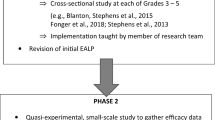Abstract
The aim of this study is to better understand the notion of early algebraic thinking by describing differences in grade 4–7 students’ thinking about basic algebraic concepts. To achieve this goal, one test that involved generalized arithmetic, functional thinking, and modeling tasks, was administered to 684 students from these grades. Quantitative analysis of the data yielded four distinct groups of students demonstrating a wide range of performance in these tasks. Qualitative analysis of students’ solutions provided further insight into their understanding of basic algebraic concepts, and the nature of the processes and forms of reasoning they utilized. The results showed that students in each group were able to solve different number and types of tasks, using different strategies. Results also indicated that students from all grades were present in each group. These findings suggest the presence of a consistent trend in the difficulty level across early algebraic tasks which may support the existence of a specific developmental trend from more intuitive types of early algebraic thinking to more sophisticated ones.








Similar content being viewed by others
References
Altieri, M. B., et al. (2008). California mathematics. Concepts, skills, and problem solving 4. Glencoe: McGraw-Hill.
Bastable, V., & Schifter, D. (2008). Classroom stories: Examples of elementary students engaged in early algebra. In J. Kaput, D. W. Carraher, & M. L. Blanton (Eds.), Algebra in the early grades (pp. 165–184). New York: Routledge.
Blanton, M., & Kaput, J. (2005). Characterizing a classroom practice that promotes algebraic reasoning. Journal for Research in Mathematics Education, 36(5), 412–446.
Blanton, M., Brizuela, B. M., Gardiner, A. M., Sawrey, K., & Newman-Owens, A. (2015). A learning trajectory in 6-year-olds' thinking about generalizing functional relationships. Journal for Research in Mathematics Education, 46(5), 511–558. https://doi.org/10.5951/jresematheduc.46.5.0511
Blanton, M., Brizuela, B. M., Gardiner, A. M., Sawrey, K., & Newman-Owens, A. (2017). A progression in first-grade children’s thinking about variable and variable notation in functional relationships. Educational Studies in Mathematics, 95(2), 181–202. https://doi.org/10.1007/s10649-016-9745-0
Blanton, M., Levi, L., Crites, T., & Dougherty, B. (2011). Developing essential understanding of algebraic thinking for teaching mathematics in grades 3-5. In B. J. Dougherty & R. M. Zbieck (Eds.), Essential understandings series. Reston: National Council of Teachers of mathematics.
Cai, J., & Knuth, E. (2005). Developing algebraic thinking: Multiple perspectives. ZDM, 37(1), 1–3.
Carraher, D. W., Schliemann, A. D., Brizuela, B. M., & Earnest, D. (2006). Arithmetic and algebra in early mathematics education. Journal for Research in Mathematics Education, 37(2), 87–115.
Carraher, D. W., & Schliemann, A. D. (2007). Early algebra and algebraic reasoning. In F. Lester (Ed.), Second handbook of research on mathematics teaching and learning: A project of the National Council of Teachers of Mathematics (Vol. II, pp. 669–705). Charlotte: Information Age Publishing.
Carraher, D., & Schliemann, A. D. (2014). Early algebra teaching and learning. In S. Lerman (Ed.), Encyclopedia of mathematics education (pp. 193–196). Dordrecht: Springer. https://doi.org/10.1007/978-94-007-4978-8_5
Chester, M. D. (2012). Release of spring 2012 MCAS test items. Massachussets Department of Elementary & Secondary Education.
Driscoll, M. (1999). Fostering algebraic thinking: A guide for teachers, grades 6–10. Portsmouth: Heinemann.
Ellis, A. B. (2007). Connections between generalizing and justifying students’ reasoning with linear relationships. Journal for Research in Mathematics Education, 38(3), 194–229.
Grove, R. (1988). An analysis of the constant comparative method. International Journal of Qualitative Studies in Education, 1(3), 273–279. https://doi.org/10.1080/0951839900030105a
IEA. (2013). Timss 2011 user guide for the international database. TIMSS & PIRLS International Study Center.
Jeannotte, D., & Kieran, C. (2017). A conceptual model of mathematical reasoning for school mathematics. Educational Studies in Mathematics, 96(1), 1–16. https://doi.org/10.1007/s10649-017-9761-8
Kaput, J. (2008). What is algebra? What is algebraic reasoning? In J. Kaput, D. W. Carraher, & M. L. Blanton (Eds.), Algebra in the early grades (pp. 5–17). New York: Routledge.
Kieran, C. (2007). Research on the learning and teaching of algebra. In A. Gutiérrez & P. Boero (Eds.), Handbook of research on the psychology of mathematics education (pp. 11–50). Rotterdam: Sense.
Kieran, C., Pang, J., Schifter, D., & Ng, S. F. (2016). Early algebra: Research into its nature, its learning, its teaching. In G. Kaiser (Ed.), ICME-13 Topical surveys. Springer Open. https://doi.org/10.1007/978-3-319-32258-2
Mason, J. (1989). Mathematical abstraction as the result of a delicate shift of attention. For the Learning of Mathematics, 9(2), 2–8.
Mason, J., Graham, A., & Johnston-Wilder, S. (2005). Developing thinking in algebra. SAGE Publications.
Matthews, P. G., Rittle-Johnson, B., McEldoon, K. L., & Taylor, R. T. (2012). Measure for measure: What combining diverse measures reveals about children’s understanding of the equal sign as an indicator of mathematical equality. Journal for Research in Mathematics Education, 43(3), 316–350. https://doi.org/10.5951/jresematheduc.43.3.0316
Mulligan, J., & Mitchelmore, M. (2009). Awareness of pattern and structure in early mathematical development. Mathematics Education Research Journal, 21(2), 33–49. https://doi.org/10.1007/BF03217544
Muthén, L. K., & Muthén, B. O. (1998). Mplus user’s guide. Los Angeles: Muthén & Muthén.
National Council of Teachers of Mathematics. (2000). Principles and standards for school mathematics. Reston: Author.
Patton, M. Q. (2002). Two decades of developments in qualitative inquiry. Qualitative Social Work: A Personal, Experiential Perspective, 1(3), 2261–2283.
Radford, L. (2000). Sings and meanings in students’ emergent algebraic thinking. Educational Studies in Mathematics, 42(3), 237–268. https://doi.org/10.1023/A:1017530828058
Radford, L. (2003). Gestures, speech, and the sprouting of signs: A semiotic-cultural approach to students’ types of generalization. Mathematical Thinking and Learning, 5(1), 37–70. https://doi.org/10.1207/S15327833MTL0501_02
Radford, L. (2008). Iconicity and contraction: A semiotic investigation of forms of algebraic generalizations of patterns in different contexts. ZDM, 40(1), 83–96.
Radford, L. (2012). On the development of early algebraic thinking. PNA, 6(4), 117–133.
Radford, L. (2014). The progressive development of early embodied algebraic thinking. Mathematics Education Research Journal, 26(2), 257–277. https://doi.org/10.1007/s13394-013-0087-2
Rivera, F., & Becker, J. (2007). Abduction—Induction (generalization) processes of elementary majors on figural patterns of algebra. Journal of Mathematical Behavior, 26(2), 140–155. https://doi.org/10.1016/j.jmathb.2007.05.00
Stylianides, G. J., & Stylianides, A. J. (2008). Proof in school mathematics: Insights from psychological research into students’ ability for deductive reasoning. Mathematical Thinking and Learning, 10(2), 103–133. https://doi.org/10.1207/S1532690XCI2001_4
Warren, E., & Cooper, T. (2008). Generalising the pattern rule for visual growth patterns: Actions that support 8 year olds’ thinking. Educational Studies in Mathematics, 67(2), 171–185. https://doi.org/10.1007/s10649-007-9092-2
Author information
Authors and Affiliations
Corresponding author
Rights and permissions
About this article
Cite this article
Chimoni, M., Pitta-Pantazi, D. & Christou, C. Examining early algebraic thinking: insights from empirical data. Educ Stud Math 98, 57–76 (2018). https://doi.org/10.1007/s10649-018-9803-x
Published:
Issue Date:
DOI: https://doi.org/10.1007/s10649-018-9803-x




